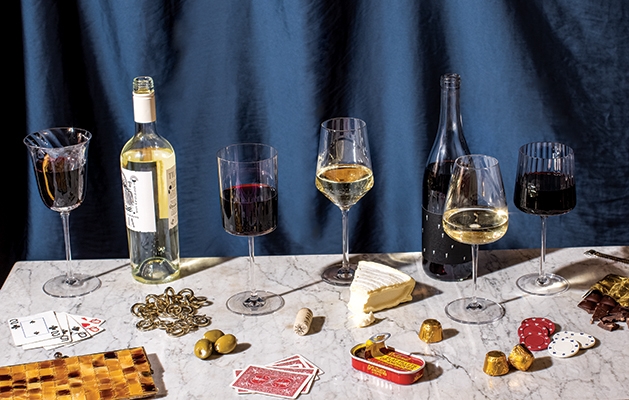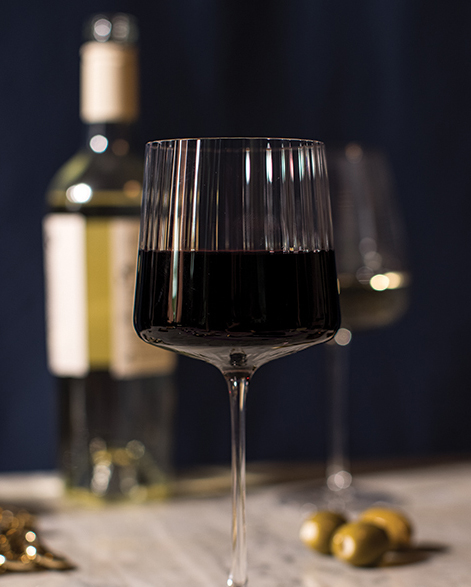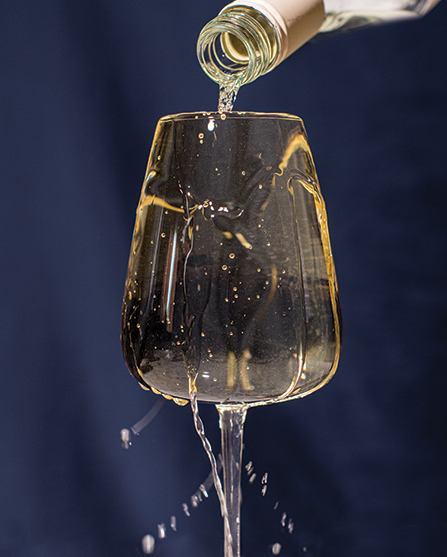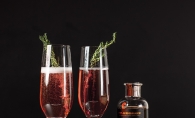
Wine can be appreciated all year, but it’s especially apropos during the holiday season. Dinner parties, restaurant gatherings and holiday gift giving tend to make wine top of mind for many revelers. So, with stemware in one hand, we connected with local experts for information to help would-be wine drinkers get more comfortable buying, ordering and gifting wine during the holidays, or for that matter, any time of year. Because, anytime can be wine time.
Sarina Garibović is a certified sommelier and owner of Ženska Glava, a woman owned and operated wine and spirits events business. Garibović became interested in wine and wine education while working in the hospitality industry and used her education to help create restaurant wine lists and teach servers how to make wine more approachable without over-simplifying. She also founded a nonprofit with fellow sommeliers call Twin Cities Somms. We asked Garibović what to look for in a wine best suited to your occasions. She says, “As a somm, what we’re thinking about is what do you usually like to drink? What flavor profiles do you already appreciate? If you love a California pinot noir, you probably like fruity wine with some acidity. Also, price is a factor for everyone, so we might ask which producers you enjoy in order to see what you’re used to paying; because you might not love a fantastic wine if you feel like you’ve overpaid!” For the adventurous types who prefer to try new things and for whom it doesn’t matter if those things align with what you already like, then Garibović tends to suggest wines from underrepresented regions like Slovenia because, “It can be good and also be a better value.”
Most importantly, Garibović encourages people to ask the staff at any restaurant or wine seller. They should know about the wines they offer. She says, “Don’t be afraid or embarrassed to ask questions, because a little bit of knowledge can go a long way, for example knowing things like more fruit character typically comes from a warmer climate where there is riper fruit and more sugar and higher alcohol. Knowing a little bit about how grapes are grown can go a long way.”
We dove deeper into our wine glass and asked Garibović’s opinion about some common wine varieties.

REDS:
Cabernet Sauvignon — In a restaurant setting, if guests say they frequently enjoy cabernet sauvignon from the Napa Valley, that gives a lot of information about the character of the fruit they may expect, whether they expect the wine to undergo barrel aging as well as the price they are accustomed to spending on a bottle. The land in Napa Valley is quite expensive and new oak barrels are used to produce many cabernet sauvignons in the area, all leading to a higher cost for the finished wine.
Merlot — Merlot used to be quite popular but has since fallen out of favor with many drinkers, arguably due to the popular movie Sideways, which created a preference for pinot noir. This makes merlot, a delicious wine worthy of frequent enjoyment, on par with a passion project for many producers. Much like cabernet sauvignon, merlot is a wine with grippier tannins, lots of ripe black fruit character and pairs well with weightier dishes like steak.
Pinot Noir — Pinot noir is a hugely popular grape variety that can express itself in wildly variable ways due to factors such as climate, soil type, aspect and aging methods. Typically, pinot noir coming from a cool place like Burgundy, the Loire Valley and Oregon will have a lighter body, show high toned red fruit and herbs with more acidity while examples from California will express themselves with richer fruit, a fuller body and more subdued acid. If you love pinot noir from Burgundy or Oregon but find the offerings restrictive due to budget, try gamay from the same places, which can offer similar qualities with a typically more affordable price tag.
Malbec — Originating in France where it is known as cot, it has really exploded in popularity and low cost examples are practically ubiquitous. The issue with malbec occurs when the cheap examples available in grocery stores cannot be found on wine lists and are instead replaced by higher quality examples at surprisingly high prices. This is because though malbec originated in France, it is now produced primarily in Mendoza, Argentina, where it can vary greatly in quality depending on where it is grown and the methods used to produce it. Stick to affordable examples when buying retail for everyday wines, but talk with your server in a restaurant for help finding a great example or another wine that matches your preferences.
Zinfandel — It can be misunderstood because of the way the grape bunches ripen on the vine. Unlike other red grapes, which ripen at relatively the same speed, becoming darker and concentrating sugars over time, zinfandel can have a bunch of grapes with green grapes, ripe grapes and raisins all at the same time. In the finished wine, this can mean a range of fruit character and perception of body and texture. More and more, producers are aiming for a more balanced zinfandel rather than pushing the limits of harvest time to get the most ripe fruit, which has in the past contributed to the perception of zinfandel as a big, jammy wine. The rich and ripe style can be great for pairing with weightier and more intense dishes, just talk to your wine pro to find out which example might be right for you and the occasion.

WHITES:
Sauvignon Blanc — Garibović says, “Sauvignon blanc is so popular, and in so many people’s comfort zone, that at times it can be hard to guide guests to any other wine on the menu.” It’s refreshing and crisp but also has a uniquely green character, like bell pepper or a gooseberry quality. It pairs well with vegetable dishes or foods with an herb component. Most folks like the crispness and fruity quality of many New Zealand sauvignon blancs, but there are other options like Sancerre from the Loire Valley in France or Styria in southern Austria that are worth trying.
Riesling — Known as the darling of somms; “We all adore it,” says Garibović. Due to the popularity of Liebfraumilch in the ‘80s (Blue Nun), there is a common idea that all riesling is sweet, creating a well-known and oft examined difficulty of selling the wine in many settings. If you like a high acid, high tone, crisp, electric white wine, you cannot find a better option with lime, lemon, apricot flavors. Though even riesling with sweetness shouldn’t be discounted, due to its high acidity, the sugar is easily balanced and sometimes practically imperceptible. Riesling is also versatile in food pairing; turn to a dry example for salads with a vinaigrette, weightier and more concentrated bottles for spicy dishes and the classically sweet styles for fruit tarts and many other desserts.
Pinot Gris — Same as pinot grigio, both are wonderful, crisp and neutral with a fresh style. Gris is from France and expresses itself differently, a little richer and with a golden hue. A bottle of gris is a wine for a table of four because it pairs with most everything.
Chardonnay — Known as a love it or leave it variety, climate and winemaking have a great impact on chardonnay as a finished wine. A fairly neutral grape, tending towards a high toned, chalky, minerally wine from cool climates like Chablis, and riper apple, and even tropical fruits when grown in a warm place like Napa, chardonnay can be many things. Chardonnay can be a wine of process like lees stirring (to create creaminess), malo lactic conversion (the source of that buttered popcorn aroma) and oak usage (vanilla aromas and flavor) are employed. So, it’s important to ask, “Where does it come from and how is it made?” Cost can be a window into style as well, since extending time before bottling and the use of new oak barrels create a lot of expense for winemakers.
Are Rosés still a thing? Garibović says, “Yes. It’s a thing and somms want to make rosé popular all year round because the idea that you can only drink it in the summer and only crisp varieties from southern France isn’t really true. There are beautiful examples from Germany, Austria and California. It also has the ability to age, so a rosé that is not from 2020 is totally fine. In fact, seek out a rosé with a couple of years of age and see how it goes. It’s basically a very light red wine, so it’s strength is in pairing, like a white wine but with some structure of red wine.”
Why is white wine served chilled and red wine is not? White wine is very frequently too chilled, and red wine not chilled enough. Most restaurants are forced to store white wine in a beer cooler at 36 degrees, which is too cold, so you probably don’t need a chiller. White wines taste better when they’ve had some time to warm up a bit. When white wines are too cold, you will have a hard time appreciating any of the aromas and character of the wine, and it will taste pretty neutral.
Red wines are best at 55–65 degrees rather than room temperature. When red wine is too warm, the alcohol overrides other flavors. So, maybe get a chiller for your red wine if it’s too warm. Stone chillers without ice can help chill wines a little or at least maintain a more appropriate temperature.
What makes a good cooking wine? I usually have a couple of unfinished bottles of wine in the fridge that I use for cooking. If you cook so much that you need specific cooking wine, go for something in the middle because the problem with low quality wines is the addition of so many things that they’re not worth using. But most people also don’t want a $20 cooking wine. If you care about the ingredients you put in your food, you should care about the sourcing of your wine for cooking. Also consider responsibly produced wine.
What’s the best bottle to bring to a dinner party or give as a gift? A host gift is one thing, but a bottle to share is different. To share, bring a bottle that pairs well with food, beaujolais goes well with lots of dishes. Or select a red from Jura in France, where you can find textured red wines with balance, and impress your friends with wine from a lesser known place! For a gift, if you want a high impact, fancy gift, give Champagne though sparkling wines can be just as good and at a lower price point. Good marketing on behalf of Champagne as a celebratory wine means it costs a lot. Garibović also recommends gifting magnums (larger bottles that hold as much wine as two standard bottles) because they have a celebratory impact and can age for longer because there is less oxygen exchange before opening. Magnums are also great for the dinner table because they’re indulgent. You can find a good one for around $60.









